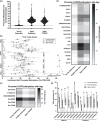Late-life exercise mitigates skeletal muscle epigenetic aging
- PMID: 34932867
- PMCID: PMC8761012
- DOI: 10.1111/acel.13527
Late-life exercise mitigates skeletal muscle epigenetic aging
Abstract
There are functional benefits to exercise in muscle, even when performed late in life, but the contributions of epigenetic factors to late-life exercise adaptation are poorly defined. Using reduced representation bisulfite sequencing (RRBS), ribosomal DNA (rDNA) and mitochondrial-specific examination of methylation, targeted high-resolution methylation analysis, and DNAge™ epigenetic aging clock analysis with a translatable model of voluntary murine endurance/resistance exercise training (progressive weighted wheel running, PoWeR), we provide evidence that exercise may mitigate epigenetic aging in skeletal muscle. Late-life PoWeR from 22-24 months of age modestly but significantly attenuates an age-associated shift toward promoter hypermethylation. The epigenetic age of muscle from old mice that PoWeR-trained for eight weeks was approximately eight weeks younger than 24-month-old sedentary counterparts, which represents ~8% of the expected murine lifespan. These data provide a molecular basis for exercise as a therapy to attenuate skeletal muscle aging.
Keywords: Rbm10; Timm8a1; Horvath clock; PoWeR; rDNA.
© 2021 The Authors. Aging Cell published by Anatomical Society and John Wiley & Sons Ltd.
Conflict of interest statement
SJW is the Founder of Ridgeline Therapeutics and, since manuscript submission, ALD‐W has become an employee of Ridgeline Therapeutics. YW is sole proprietor of Myoanalytics LLC. No other conflicts are declared.
Figures


References
-
- Blocquiaux, S. , Ramaekers, M. , Van Thienen, R. , Nielens, H. , Delecluse, C. , De Bock, K. , & Thomis, M. (2021). Recurrent training rejuvenates and enhances transcriptome and methylome responses in young and older human muscle. Journal of Cachexia, Sarcopenia and Muscle Rapid Communications. 10.1002/rco2.52 - DOI
-
- Chew, Y. C. , Guo, W. , Yang, X. , Jin, M. , Booher, K. , Horvath, S. , & Jia, X. Y. (2018). A High‐throughput targeted bisulfite sequencing‐based analysis for epigenetic age quantification and monitoring. The FASEB Journal, 32(1), 674.8–678. 10.1096/fasebj.2018.32.1_supplement.674.8 - DOI
-
- Distefano, G. , Standley, R. A. , Dubé, J. J. , Carnero, E. A. , Ritov, V. B. , Stefanovic‐Racic, M. , Toledo, F. G. , Piva, S. R. , Goodpaster, B. H. , & Coen, P. M. (2017). Chronological age does not influence ex‐vivo mitochondrial respiration and quality control in skeletal muscle. Journals of Gerontology Series A: Biomedical Sciences and Medical Sciences, 72(4), 535–542. 10.1093/gerona/glw102 - DOI - PMC - PubMed
-
- Figueiredo, V. C. , Wen, Y. , Alkner, B. , Fernandez‐Gonzalo, R. , Norrbom, J. , Vechetti Jr, I. J. , Valentino, T. , Mobley, C. B. , Zentner, G. E. , Peterson, C. A. , et al. (2021). Genetic and epigenetic regulation of skeletal muscle ribosome biogenesis with exercise. Journal of Physiology, 599, 3363–3384. - PubMed
-
- Hannum, G. , Guinney, J. , Zhao, L. , Zhang, L. I. , Hughes, G. , Sadda, S. V. , Klotzle, B. , Bibikova, M. , Fan, J.‐B. , Gao, Y. , Deconde, R. , Chen, M. , Rajapakse, I. , Friend, S. , Ideker, T. , & Zhang, K. (2013). Genome‐wide methylation profiles reveal quantitative views of human aging rates. Molecular Cell, 49(2), 359–367. 10.1016/j.molcel.2012.10.016 - DOI - PMC - PubMed
Publication types
MeSH terms
Grants and funding
LinkOut - more resources
Full Text Sources
Other Literature Sources
Medical
Molecular Biology Databases

